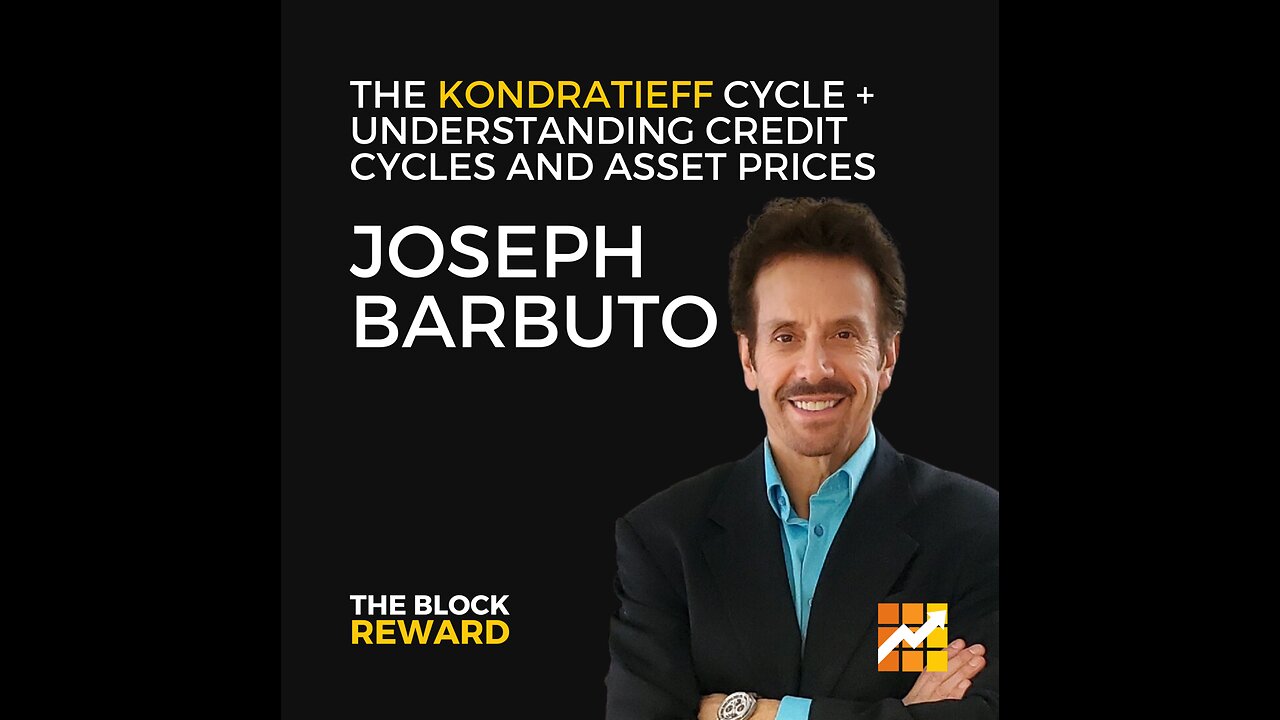Premium Only Content

What The Kondratieff Cycle Tells Us About Asset Prices - Joseph Barbuto
Welcome to the Block Reward Podcast, your go-to source for delving into the world of Bitcoin! 🚀 Our mission is to simplify Bitcoin for beginners through engaging conversations with subject matter experts. Tune in every Tuesday for fresh insights and knowledge. Don't forget to hit the like button, subscribe, and turn on notifications to stay updated on our latest episodes! 🎙️ Find Scott on twitter @lanternbitcoin #bitcoinforbeginners #bitcoin #bitcoinpodcast
In this podcast episode, Scott and Joseph Barbuto discuss Joseph's economic long wave theory and its relation to the real estate market in Canada. He explains the different phases of the economic cycle and the impact of unproductive debt on the economy. Barbuto predicts the end of the current fiat monetary system within a decade and discusses the factors driving real estate prices. He emphasizes the importance of understanding economic cycles and the role of interest rates in determining asset prices. He also discusses the future of technology, the potential for decentralized systems, and the role of gold and Bitcoin in the monetary system.
Joseph is the founder of the Economic Longwave, a forecasting model that predicts boom and bust cycles based on the availability and price of credit. The Kondratieff Wave, also known as the Kondratieff Cycle or K-Wave, is a long-term economic theory that suggests capitalist economies go through distinct cycles of expansion and contraction, typically lasting around 50 to 60 years each. This theory was proposed by Russian economist Nikolai Kondratieff in the 1920s.
What We Discuss:
[00:00:45] Joseph shares how he discovered the long wave theory and its relation to his career in the investment business.
[00:06:03] Explanation of the different seasons of the long wave, including economic spring, economic autumn, and economic winter. As well as the falling price of credit.
[00:08:51] Joseph discusses the relationship between credit and economic activity in the long wave theory, emphasizing the importance of productive debt and the consequences of excessive unproductive debt.
[00:14:13] Discussion on the correlation between real estate prices, population growth, and affordability in Canada from the 1940s to the present.
[00:21:09] Advice on how individuals can prepare for the upcoming economic crisis, including deleveraging and living within one's means.
[00:26:14] Discussion on how interest rates affect real estate prices and the importance of credit in the long wave theory.
[00:30:34] Exploration of how the interest rate policies in the last 15 years differ from historical norms and the potential consequences, and how we are a credit based economy.
[00:35:41] Addressing the belief that governments can prevent a collapse and the need to consider higher interest rates in the future.
[00:37:54] Discusses the approaching economic winter where defaulting and government debt explosion will occur.
[00:40:35] Explores the role of sound money, gold, and the collapse of the current monetary system.
[00:41:40] The most important thing you need to know about the long wave theory.
[00:42:48] Discusses the fifth wave driven by information, computer revolution, genomic revolution, artificial intelligence, and other technologies.
[00:50:59] Explores the advancements in stem cell technology and its potential to revolutionize healthcare by repairing and preventing diseases, ultimately eradicating disabilities.
[00:57:40] Discusses the place of gold as a transitory asset leading to digital gold or Bitcoin, which is seen as the future of money due to its technological advancements and potential for everyday use.
[01:01:45] Joseph discusses his belief that by 2040, Bitcoin will emerge as the dominant monetary system over gold due to technological advancements and global adoption rates.
Are you a Canadian employer thinking about bitcoin as a tool for recruitment and retention? Visit www.blockrewards.ca to learn how we are helping companies reimagine their compensation and rewards strategies using the hardest money that has ever existed.
-
![🔴[LIVE] Stocks Bounce, Breaking Tariff News & Live Trading || The MK Show](https://1a-1791.com/video/fww1/05/s8/1/Z/u/X/B/ZuXBy.0kob-small-The-MK-Show-Apr.-14th.jpg) LIVE
LIVE
Matt Kohrs
11 hours ago🔴[LIVE] Stocks Bounce, Breaking Tariff News & Live Trading || The MK Show
1,336 watching -
 LIVE
LIVE
Badlands Media
9 hours agoBadlands Daily: April 14, 2025
4,582 watching -
 1:12:57
1:12:57
Dear America
15 hours agoTrump Greeted With Roars From UFC Crowd + Bill Maher & Shaq Join Team MAGA?!
32.2K7 -
 LIVE
LIVE
Wendy Bell Radio
5 hours agoDon't Let The Bastards Grind You Down
9,699 watching -
 1:27:44
1:27:44
Game On!
18 hours ago $5.02 earnedWe have a MASTERS CHAMPION!
35.1K2 -
 12:27
12:27
Tactical Considerations
15 hours ago $3.62 earnedTop 3 Striker Fired Pistols That DOMINATE The Range in 2025
29.4K3 -
 25:35
25:35
JasminLaine
16 hours agoLiberals CAUGHT Planting Evidence to Frame Poilievre—CBC Host Gets FACT-CHECKED Into Oblivion
30.4K44 -
 1:37:56
1:37:56
TheDozenPodcast
21 hours agoWhy Capital PUNISHMENT needs restoring: Ex Detective exposes Child Protection Unit
44K4 -
 2:02:22
2:02:22
BEK TV
2 days agoTrent Loos in the Morning 4/14/2025
29.5K2 -
 20:18
20:18
DeVory Darkins
17 hours ago $23.99 earnedTrump SMACKS DOWN media as Democrats cry for Pete Hegseth to be Fired
94.5K148